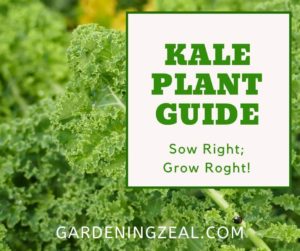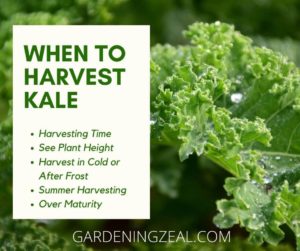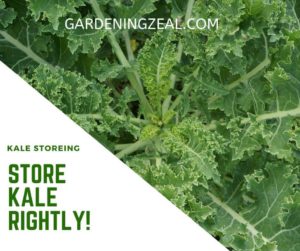Are you thinking about “How to harvest kale” that you have grown in the yard and now want to have on your platter?
No need to be worried if you have not found the right way of harvesting kale because this ultimate guide on ‘When and how to harvest kale plant’ will open up all the knots in your mind regarding kale harvesting.
Let’s dig in!
Key Learning Points
Know About Kale Plant
Green leafy Kale, a member of the cabbage family is must grow green in the garden because of its nature of growth and nutritional significance.
Rich source of carbohydrates and protein, green kale is cool season green capable of tolerating frost.
Instead, leafy green vegetable demands frost as frost adds sweetness to its flavor.
Due to its high nutritional content, kale is been widely used in cooking and even used uncooked as salad or in garnishing.

Kale Plant Guide – When and How to Harvest Kale
Most cold tolerant brassicas, Kale is the plant that demands frost feast!
It requires frost for better flavor development that you can also compare by dinning kale leaves before after frost.
You will clearly observe the difference in taste.
-
Sow Right
In order to harvest bulk leaves in fall or winter, you have to sow the seeds rightly so that you can grow rightly.
Sow the seeds about ½ inch deep in the seedbed in rows almost 6 inches apart. Water the seeds on time and take good care of the seedbed to have good results.
-
Grow Right
If you have sown seeds at times inappropriate conditions, you are going to have fresh kale leaves soon.
When you see three to four leaves growing, transfer the plants to their growing position in such a way that the lowest leaves are set at ground level.
Water well. Keep a pace among plants almost 20 inches apart.
By giving water timely and proving feed in spring plants will give the best growth.
When to Harvest Kale – Harvesting Kale
If you have grown kale and now worrying about when to harvest kale, you must be glad to know that it is a winter-loving plant and gives the best sweet flavor if harvest after frost.
It grows best in spring or fall depending upon the time you planted.
Kale planted in late summer will be ready till early fall, while if you plant in winter or spring you will get till late spring or early summer.
-
Harvesting Time
Mainly, harvesting time depends on your plan to grow kale. If you grow plants from seeds, you can harvest about 2.5 months after planting.
But if you are going to transplant you can expect to harvest after 50 – 55 days of planting.
-
See Plant Height
If you want to pick leaves with full taste, wait to reach plant height up to 8 inches so that they can reach the size of a hand.
Give water timely and harvest regularly to grow leaves even for months.
-
Harvest in Cold or After Frost
Kale can grow in the cold where the temperature is about 80 Fahrenheit. It can also survive frost!
Normally it is said for plants to harvest before frost, but exceptionally kale is one of few plants that not only survive cold but also requires frost for more flavor.
Frost adds more sugar and sweet taste to leaves.
Suggestions to embrace frost
- Transplant seedlings about 6 weeks before frost, or grow by sowing for about three months before expected frost so that you can harvest after full flavor is added.
- You can also harvest some of the leaves before you expect frost in your area and wait for new leaves to embrace frost.
Generally, kale survives cold, but if you live in an area where the temperature falls down to 32 Fahrenheit, you need to protect the kale plant by insulating with covers or frames.
By doing this your plant will be safe from harsh cold and grow steadily.

-
Summer Harvesting – When to Harvest Kale
As kale is a frost loving plant and usually doesn’t like the heat of summer. Leaves get tough and bitter in hot when the temperature reaches 80 or more.
It shows if you plant kale in spring, by the end of summer you will feel leaves with a bitter flavour.
So, if you want sweet tasty kale leaves to enjoy fresh salad in fall or winter you need to harvest almost one-third of leaves in summer.
You can add harvested leaves to compost.
New sweet leaves will develop till winter for your fresh food.
-
Over Maturity
Grow kale as it is a widely and rapidly growing plant but in order to use its leaves keep noticing its maturation level.
It can spread several feet wide and up to 2 to several feet tall depending upon variety.
If you see flower buds or stalks, it means it is over matured. Its over-maturation causes a bitter taste in leaves that is inappropriate for use and devalues them.
In order to delay over-maturity, cut down the floral stalks before blooming. But you still need to harvest at a time before delaying as it can spoil your taste.
How Do You Harvest Kale – Are You Doing Right?
Harvesting kale in the right way is as essential as the life of a plant!
There is always a right and a wrong way of anything, so is the way of harvesting kale leaves that if you properly pick, your plant will grow continuously without any problem.
But if you pick leaves unknowingly, it may cause trouble for your kale.
So, before harvesting this season, must read given right ways of harvesting kale so that it will not die and grow continuously.

How to Harvest Kale So It Keeps Growing – Step by Step
A well-concerned question ‘How to Harvest Kale’ is worth questioning because of the strategy you must follow to harvest kale.
Although it’s tricky not a big deal, you just take care in picking so that rest of the plant leaves remain intact.
- Moving on towards harvesting leaves, you have to take a sharp knife or a pair of pruning shears according to availability, and a jar to put all the leaves in it.
- When you are done with it, hold the leaves with one hand and cut from the stem in the way you cut the entire leaf.
- Keep in mind that you have to take old and large leaves.
- Older leaves grow towards the outer side while the inner top side contains fresh tenders that you must not damage or cut.
- If you see any damaged leaves showing holes or getting pale, cut them and add them to the compost heap.
- Kale plant leaves need to be harvested routinely. If you will leave on plants, they will be somewhat bitter and tough.
- This green leafy plant suggests picking earlier rather than late!
- Always cut outer leaves that are at the bottom without damaging baby kale leaves. Never cut central bud as it is the growing area of the plant.
- Do not pick too many leaves from a single plant at a time as it will affect its growth rate. Try to leave about 1/3 of the leaves intact.
So, after knowing simply easy tricks, you can practice on your own to pick kale leaves from your garden.
Things You Must Consider When Harvesting Kale from Your Garden
You must keep an important thing in mind that it takes almost 5 -7 days to develop new leaves from the kale plant, so leave some new central leaves so that plant remains productive.
Grow 4-5 kale plants, that you can easily in pots if lack room in the garden so that you can take a handful of leaves from each plant to enjoy an all-time fresh salad.
Do not cut from roots while harvesting leaves because as leaves grow on stem. If you cut from roots, you are pushing your plant to death.
Kale Plant Dying – Pick Whole
If your plant is grown enough and goes to seed or the temperature has fallen below its tolerance level (below 20oC), it may die.
Before its death, you should harvest all of its leaves and pick the whole plant by cutting from the stalk. Cut the plant stalk near the soil.
You can use these leaves immediately or store them properly for later use as guided below.
Storing Harvested Kale Leaves – How to Store Kale Leaves?
When you are done with all harvesting of kale leaves considering the weather and all other factors, you can store them in the right way to use even after weeks.
Take your leaves filled jar to sink and wash thoroughly to remove any dirt or debris. As plants are susceptible to various pests and sometimes, you spray plants to prevent diseases.
Washing with tap water before saving will free from health concerns.
Tip: Never use hot water or soak the leaves as it causes wilting.
Spread the leaves over a clean and dry place or on a paper towel and air dry before packing.
Tip: Don’t store wet leaves as fungus can grow in moisture.

Take a plastic ziploc or resealable bag and place leaves. You can also place a paper towel under leaves for better protection.
Tip: Remove air properly before sealing.
Label the bag with the date you are storing it so that you can use it accordingly without forgetting when you stored it.
Place in refrigerator.
Tip: One to two or three weeks are ideal to store kale leaves fresh.
How to Store Kale Without Plastic?
Storing food; vegetables and fruits, without plastic bags is the main concern in the emerging world.
It is beneficial not only for food but is a SIGNIFICANT NEED to overcome climate change, a devastating reason of which is excessive use of plastics.
Thanx to the plastic alternative storage options like; organic cotton bags, mesh bags although use for groceries, French terry bags are recommended ones to store leafy greens in these plastic-free bags.
You can also store in
- Glass containers
- Tea towels
What you have to do is
Properly wash and completely dry the leaves with a paper towel as guided above.
Removing any moisture is essential to prevent rotting so, try to dry maximum.
Remove the stems.
- Wrap the hardy green kale in a paper towel loosely, place it in a glass container and store it in the fridge.
- You can also place kale veg simply in a cup of water just like a bouquet in the fridge but not in a crowded place.
- You can also freeze your green! To freeze, just blanch the leaves after removing the stem and thoroughly washing.
Boil for 25 – 30 seconds and give them heat shock by transferring to an icebox. It will give them crisp rather than wilting.
After doing this, stain all of the water and tap with a towel to dry them out.
Wrap in a beeswax wrap and freeze for later use.
So, hopefully, all of your puzzling questions and tied knots about ‘When and how to harvest kale plant’ are solved.
Now you are in a position to harvest leaves when you see grown with critical analysis and after determining all aspects of harvesting that not only you can use immediately but store for later foods.
Now you can have a green leafy platter when you want!
Leave a Reply